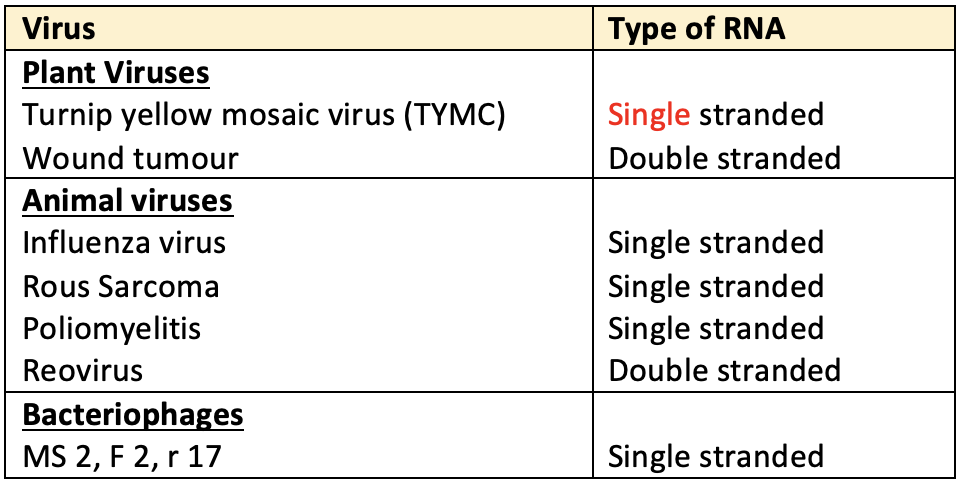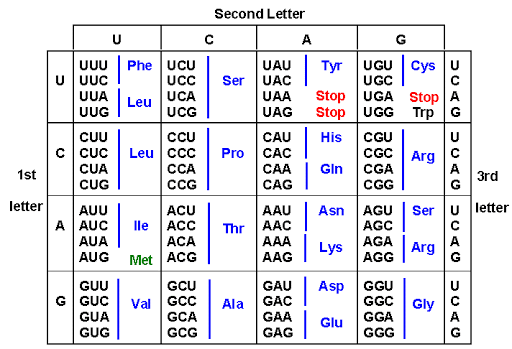🧬 Genetic material
Learn about Genetic material and Codon.
Genetic Material
- Genetic material DNA & RNA are chemically called nucleic acids. Genetic materials are DNA & RNA
- DNA: Deoxyribose Nucleic Acid
- RNA: Ribose Nucleic Acid
- Genetic material in most of the organism is DNA.
- ‘DNA’ is the genetic material and not the protein’ was described by O.T. Avery, C.H. Macleod and M. Mc Carty on E. coli in 1944.
- Nucleic acids were first isolated by Miescher (1868) from the nuclei of white blood cells (WBC) of pus.
- First time In vitro synthesis of DNA:
A. Kornberg - In vitro synthesis of RNA:
S. Ochoa - Artificial Synthesis of gene which coded for alanine transfer RNA (t RNA) from yeast:
H.G. Khorana&K.L. Agrawal. - One gene - One enzyme hypothesis was given by
Beadle & Tatumin 1943 while working on biochemical, mutant Neorospora crassa (fungus). - How gene operates? i.e. operon concept of gene was given by
Jacob & Monod. - Modern concept of gene i.e. gene fine structure was given by
Benzer - According to the classical concept, the smallest unit for recombination, mutation & function was only gene. But Later on three terms have been coined by Benzer viz.
Reconis the smallest unit for recombination. It consists of maximum of two pairs of nucleotides & may be only one.Muton: It is the smallest unit of mutation. An alternation in a single nucleotide pair can result in the mutation. Muton is thesmallestin size.Cistron: It is the functional unit where hundreds of nucleotide pairs take part. It is thelargestin size. Generally we use ‘gene’ instead of cistron.
- One gene controls one character
- One gene → One protein
- One gene → One chain
- One gene → One-polypeptide
- One cistrone → One polypeptide
Structure of DNA
- According to J.D. Watson & F.H.C. Crick (
1953) - DNA molecule has two polynucleotide chains which are wrapped helically around each other in such a way that sugar-phosphate chain is on the outside and purine (A, G) pyrimidine (C, T) on the inside of the helix.
- E. Chargaff & et. al observed that:
- The concentration of thymine was always equal to the concentration of adenine and the conc. of cytosine was always equal to the conc. of guanine.
- The total conc. of Purines (A + G) was always equal to the total conc. of Pyrimidine (T+C)
- But the ratio of (A+T)/(C+G) called
Base pair ratiowas found to vary widely in DNAs of different species. - The two polynucleotide strands are held together by hydrogen bonds between specific pairs of purines & pyrimidines.
- Adenine is always paired with Thymine by two hydrogen bonds and Guanine is always paired with Cytosine by three H-bonds.
- The base pairs are stacked
3.4 A°apart with10 base pairsper turn (360°) of the double helix.
- Once the sequence of bases in one strand is known, the sequence of bases in the other strand is also known because of the specific base-pairing.
- The two strands are thus said to be
complementaryi.e. not identical. Means the sequence of nucleotides in one chain dictates the sequence of nucleotides in the other. The two strands runanti-paralleli.e. have opposite directions. - Both polynucleotides strands are separated by
20 A°distance.
Structure of RNA
- RNA is either single stranded or double stranded but not helical like DNA.
- In most plant viruses, genetic material is RNA. In many bacteriophages, genetic material is RNA.

- When RNA is double stranded, it generally follows the same rules of base pairing as in case of DNA.
- The non-genetic RNAs except t RNA (of prokaryotes & eukaryotes) also have single stranded t-RNA (s-RNA is soluble and non-genetic) is double stranded but non-helical.
- Each strand of RNA is polynucleotide. RNA is the genetic material where organisms have only RNA (not DNA) but organisms which have DNA along with RNA, use of the RNA is carrying the orders of DNA and in this way RNA has no genetic role so called non-genetic RNA. Non genetic RNA is synthesized on DNA template. Non genetic RNAs are m-RNA, t-RNA & r-RNA.
- Genetic RNA of viruses is self-replicating i.e. it can-produce its own replica by itself. So its model of replication is called
RNA-dependent RNA synthesis.

Genetic Code
- R.H. Holley, H.G. Khorana & M.W Nirenberg got Nobel Prize for deciphering the genetic code.
- DNA molecule is the carrier of genetic information. This information is in the form of certain special language of code words which utilizes the four nitrogen bases (e.g. ATCG) of DNA for its symbols. Such coded message is called cryptogram.
- Nucleic acids govern the protein synthesis. Proteins have 20 different amino acids but nucleic acid has only 4 different bases. It means 20 amino acids are the alphabets of the language of Proteins but 4 bases are the alphabets of the language of nucleic acids. Genetic information are passed on to the protein synthesis through mRNA.
- Since 20 amino acids are to be coded, triplet code of bases gives 4x4x4 = 64 codons which are enough.
- Out of 64 triplets, 44 triplets are excess which show that more than one codon are present for the same amino acids.
- An anticodon is a sequence of three nitrogenous bases found on t-RNA.
- Primary structure of protein is amino acids. These essential amino acids are
20 in numberviz:

Characteristics of triplet code

- The code is triplet: Singlet and doublet codes are not enough to code for 20 amino acids. Triplet code is the minimum requirement.
- The code is degenerate: In triplet code for a particular amino acid
more than one word (synonyms)can be used. This is called degenerate code but in a non-degenerate code there would be one to one relationship between amino acids and the codons. So that 44 codons out of 64, will be useless codons e.g. 3 amino acids-arginine, serine & leucine each has six synonymous codons. All codons starting with CC specify proline (CCU, CCC, CCA, CCG). - The code is non-overlapping means a base in an mRNA is not used for two different codons. The same base cannot be used for two different codons for synthesis of the same amino acid. The same base can be used for different codons only at different occasions in time and/ or space.
- The code is comma less. No codon is reserved for punctuation. After the coding of the one amino acid, the second amino acid is automatically coded by the next three letters.
- The code is ambiguous means the same codon may specify more than one amino acid. e.g. UUU codon usually code for phenylalanine but in presence of streptomycin, may also code for isoleucine, leucine or serine.
- The code is universal i.e. the same code applies in all kinds of living systems.
- Starting codons:
AUG codonis called starting or chain initiation codon which initiates the synthesis of polypeptide chain. - Non-sense codons: The
UAA,UGA&UAGcodons do not specify any amino acid. Therefore these codons are called non-sense codons or termination codons. Termination codons terminate the translation of a particular polypeptide.
https://youtu.be/veB31XmUQm8 https://youtu.be/BIP0lYrdirI https://youtu.be/_aAhcNjmvhc
Genetic Material
- Genetic material DNA & RNA are chemically called nucleic acids. Genetic materials are DNA & RNA
- DNA: Deoxyribose Nucleic Acid
- RNA: Ribose Nucleic Acid
- Genetic material in most of the organism is DNA.
- ‘DNA’ is the genetic material and not the protein’ was described by O.T. Avery, C.H. Macleod and M. Mc Carty on E. coli in 1944.
- Nucleic acids were first isolated by Miescher (1868) from the nuclei of white blood cells (WBC) of pus.
- First time In vitro synthesis of DNA:
A. Kornberg - In vitro synthesis of RNA:
S. Ochoa - Artificial Synthesis of gene which coded for alanine transfer RNA (t RNA) from yeast:
H.G. Khorana&K.L. Agrawal. - One gene - One enzyme hypothesis was given by
Beadle & Tatumin 1943 while working on biochemical, mutant Neorospora …
Become Successful With AgriDots
Learn the essential skills for getting a seat in the Exam with
🦄 You are a pro member!
Only use this page if purchasing a gift or enterprise account
Plan
Rs
- Unlimited access to PRO courses
- Quizzes with hand-picked meme prizes
- Invite to private Discord chat
- Free Sticker emailed
Lifetime
Rs
1,499
once
- All PRO-tier benefits
- Single payment, lifetime access
- 4,200 bonus xp points
- Next Level
T-shirt shipped worldwide

Yo! You just found a 20% discount using 👉 EASTEREGG

High-quality fitted cotton shirt produced by Next Level Apparel